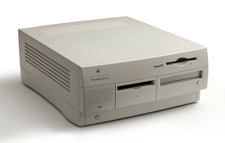 I started using Macs shortly after the release of OS X back in 2001. Not being a lifelong Mac user, I tended to view Macs running OS X as UNIX boxes with a great UI and the ability to run some mainstream software.
I started using Macs shortly after the release of OS X back in 2001. Not being a lifelong Mac user, I tended to view Macs running OS X as UNIX boxes with a great UI and the ability to run some mainstream software.
I’ve spent most of my career in software development working on various UNIX platforms, so I used my Macs more as UNIX workstations (lots of terminal windows and X11 apps open at any time) than as consumer machines. Since I have a dislike for all-in-one computers, my machine of choice for the longest time had been the PowerMac. Despite the top end Apple tower being a multi-processored monster, there was always a low-end model available that, while not as awesome, was always just as expandable, easy to work on, and reasonably priced. My first Mac was a second-hand PowerMac G3, followed several years later by a G4. Finally, I splurged and bought a mid-range dual processor G5 Tower. All were great machines, in fact, the G4 is still being put to use as a test server running Debian.
That changed when Apple switched processor architectures from PowerPC to x86. The PowerMac was replaced with the
Mac Pro, a machine crammed with server grade components that is unjustifiably expensive for all but the most demanding (and

wealthy) users. In order to fill the gap, Apple beefed up their iMacs, which now sport large IPS screens, quad-core processors, and decent (though not high-end) GPUs. Priced out of my preferred machine configuration of tower-plus-dual-monitors, I decided to buy a 27″ quad-core iMac, a machine which proceeded to validate all of my long-held negative opinions regarding all-in-one computers, while shattering my long-suffering brand loyalty towards Apple.
A few months after bringing home my new iMac, I noticed a problem. Dark smudges were appearing INSIDE the LCD. Since the machine was under a year old, I took it to the nearest Apple Store. I lost the machine for several days, thus illustrating my number 1 beef against all-in-ones — no user-serviceable components. If the monitor (or any other part) dies, you can’t just swap it out for another and keep working, you get to take the whole machine in for service, causing you to get behind on whatever project you’re working on at the time. Anyway, I got the machine back with a new LCD, and figured it was just a defective component.
Next, the optical drive quit. I was in the middle of working on a project, and so decided not to take it back to the Apple Store right away (I was forced to dig an old external USB CD-R drive out of my closet). Not long after this however, the LCD started dying again in the same manner. So, back to the Apple store I went, and after about a week I had my machine back, with another new LCD. Since I was now nearing the end of my 1-year warranty, I purchased AppleCare for the first time in my Mac-using life.
At this point, I had a serious conversation with myself about why I was spending so much money on Apple products when the quality had clearly become sub-par. I also asked myself what I could do on a Mac that I couldn’t do on a Linux box, and the answer was: not much. Maybe Photoshop, but that can be run on Windows, either via WINE or a Windows install on a virtual machine (or if the performance wasn’t good enough with the aforementioned options, I could always install both Linux and Windows on one machine and dual-boot).
For the time being, however, I had a once-again operational Mac so the issue wasn’t pressing. Then, it happened again. LCD number THREE bit the dust. Same failure. I walked into the Apple Store and had to fight back the urge to hurl the thing in the general direction of the “Genius” Bar and walk out. But alas, I just walked up to the counter, plopped my POS iMac down, and demanded a full-replacement. The “Genius” behind the counter gave me a quick deer-in-the-headlights look, then went to fetch the store manager.
I explained to the manager that my iMac had had its LCD replaced TWICE, it’s clearly an unreliable machine, and I need to get a new one. He then suggested that the damage was due to environmental factors and asked me if I smoke. I explained that I don’t smoke, that I use my computers in a suburban home office setting (with a few non-Apple LCDs that have never had a problem), and that no, I can’t set up a class-1 cleanroom in my house in which to use my Apple products.
After some back-and-forth, he told me that they can’t replace the machine, but they’ll happily replace the LCD again. I then told the “Genius” that after 10 years as a loyal Mac user, I would be moving my work flow to Linux, and that this iMac would be the last Mac I ever bought. But, as a matter of principle, I’m going to bring the machine back every few months for another $700 LCD replacement since I had purchased AppleCare. I left, went directly to a PC parts shop, and bought all the components I needed to build a nice Linux workstation.
 I’m pretty sure Apple doesn’t care about users like me, as they seem to have turned their focus toward producing products for the consumer market while systematically dismantling their professional user base. The recent Final Cut Pro X introduction fiasco is a good example of this. There are even rumors circulating that Apple is considering killing the Mac Pro — they already killed the XServe (without warning), basically exiting the enterprise market and screwing over whatever corporate customers they had. The uncertainty over Apple’s future plans is driving away a lot of professional users. It’s kinda sad to watch, but I guess it won’t be my problem anymore.
I’m pretty sure Apple doesn’t care about users like me, as they seem to have turned their focus toward producing products for the consumer market while systematically dismantling their professional user base. The recent Final Cut Pro X introduction fiasco is a good example of this. There are even rumors circulating that Apple is considering killing the Mac Pro — they already killed the XServe (without warning), basically exiting the enterprise market and screwing over whatever corporate customers they had. The uncertainty over Apple’s future plans is driving away a lot of professional users. It’s kinda sad to watch, but I guess it won’t be my problem anymore.

How much was the total cost of the PC for the Linux workstation?
LikeLike
If memory serves, somewhere around $1200 for everything, including two monitors.
LikeLike
Hi James.
Thank you for taking your time to share your experience.
I’ve never ever used Mac before but I bought an iPhone 4S and I like it a lot.
I’ve been using Linux for a long time but because I liked my iPhone so much, I am considering buying a Macbook Pro 13.3″
Based in what you wrote here, you would not recommend it, right?
By the way, I just started learning Python and I would like to became a developer / data analyst in the next three years. Any advice?
Thanks and happy new year.
David
LikeLike
Thanks for your thoughts James. I have been using Macs since the age of 5 and I have been endeared to them for a long time. I have used other OS’s but have gone back to the Mac for my daily computing.
After they unveiled the new Mac Pro and taking into account their complete push for a closed architecture (both hardware and software), I decided it was time to leave the reservation.
It’s time to quit being robbed hardware wise and forced to overpay for memory and such.
Linux is my new home. No more creepy big companies to mess with.
LikeLike
I checked out the new Mac Pro on Apple’s website out of curiosity. All I can say is… wow — they went in exactly the opposite direction they should have.
LikeLike
I’ve just found your article; a very interesting commentary, thank you. I switched from Windows to Mac in the late days of OS9, to upgrade my business customer base – I was a typographer/typesetter. I’m retired now, and today was decision day, I’m moving to Linux. My reasons are pretty much the same as yours, although I have a laptop with external monitor so as to have a dual-screen setup for InDesign. The OS is nothing like as efficient or reliable as it used to be; the deterioration since the introduction of Leopard, at least, is very noticeable. Screwing over its (Apple’s) corporate customers is bang on target, typified by the sudden and silent removal of support for PostScript fonts, reinstated a few days later with a software update, due to pressure from corporate customers. I don’t need Adobe’s professional apps any more, so no problems there.
The learning curve is going to be interesting. 🙂
LikeLike
Sorry, I was interrupted before I’d finished my other post. Another, big, reason for dumping the Mac, is Apple using that cash mountain for their share buy-back. Companies who do this are only interested in making money for their senior executives, not product development. This cash should be for recruiting and keeping the design talent they need, the future Jonny Ives, and innovation. That buy-back is a clear indication of Apple’s plans for the future, and it doesn’t include enterprise-class computers.
LikeLike